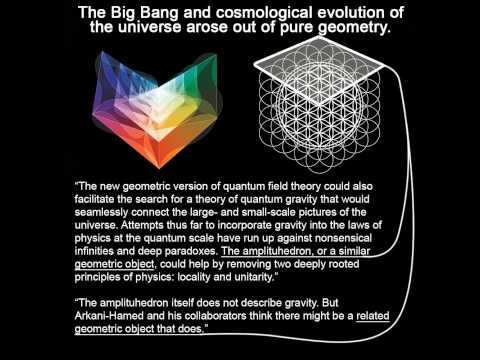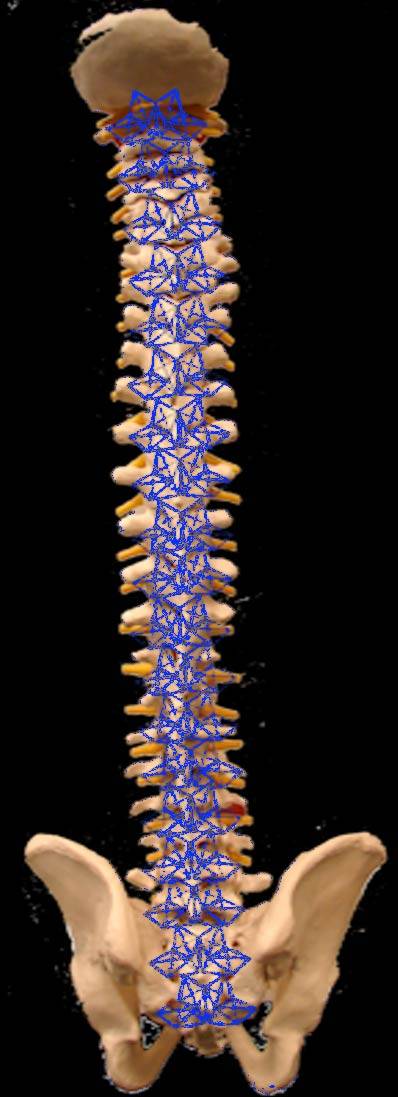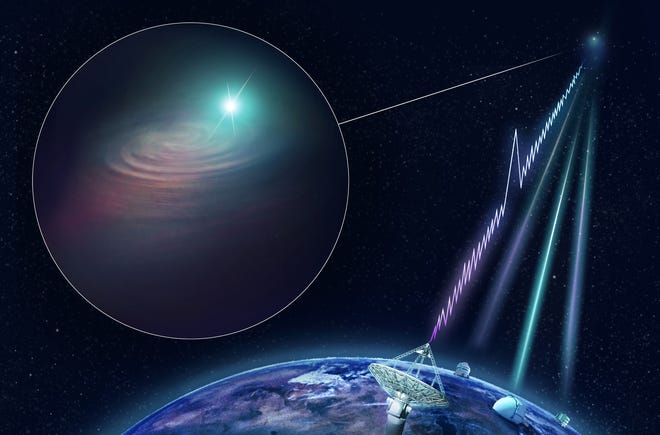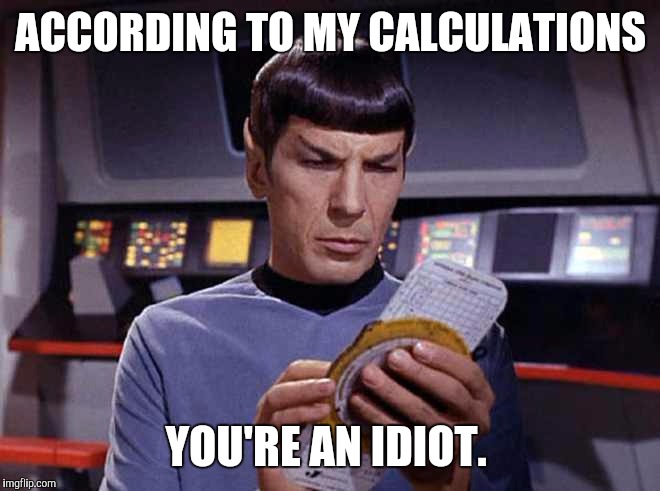it_is_the_light
Gold Member
- Thread starter
- #21
The 6TH Platonic Solid is realized .. inside your Spine
The Reference Frame: Mysterious positivity of the Amplituhedron

Mysterious positivity of the Amplituhedron
Some comments on papers by Susskind; and Arkani-Hamed et al. (twice)
So far, the latest arXiv preprints emerged on December 31st. The paper arXiv:1501.00001 (with the new redundant zero) should be out on Monday.
On the Sylvester day (for Yankees: 1/2 of Europe plus Israel uses this name for New Year's Eve), three hep-th papers were authored or co-authored by very famous physicists. One was by Nima, another one was by Arkani, and the third one was... by Susskind.

Leonard Susskind wrote an essay about the ER-EPR (worhhole-entanglement) correspondence and especially about the interpretation of the GHZ states and quantum teleportation within the paradigm started by Maldacena and Susskind. It's fun to read Lenny's papers but I found the issues in this new paper sort of obvious, so I don't think that there's something new for me to learn here.
Susskind tries to solve some "potential paradoxes" involving entanglement and measurements by different observers in different orders that could lead to inconsistencies if ER-EPR is assumed to hold as well. I find it trivial to see – or trivial to prove – that no such inconsistencies can possibly exist. At the end, the ER-EPR correspondence is just assigning a new, wormhole-like interpretation to some special states in the Hilbert space of two or numerous black holes (or other objects).

Because there is no inconsistency in quantum mechanics, there can't be any inconsistency in the same quantum mechanics presented along with some new names (or illustrations) for some of the basis vectors in the Hilbert space. The real point is that the different "labels" for the different bases of the Hilbert space can't be in conflict with each other because they provide us with complementary, inequivalent, but mutually not contradicting descriptions of the same thing.
In principle, we may assume that we analyze a Hilbert space of two black holes whose microstates may be entangled in any way; or one Einstein-Rosen bridge whose throat may be filled with some arbitrarily entangled matter. There is no way to fully decide which description – which topology – is the right one. Whether the two black holes are connected by a bridge may only be found by the agreement in the infalling observers' observations and the same agreement – correlation – may be guaranteed by entanglement. Moreover, no GR-based observations in the shared black hole interiors may influence other observations by the outside observers because the future of the observers inside ends up in the singularity. The guaranteed death of the people inside the black holes and bridges reduces or eliminates the potential for new contradictions.
That's also why the topological invariants of the spacetime – the number of bridges between black holes, for example – aren't well-defined Hermitian operators (i.e. observables) on the Hilbert space. You must start your description by deciding about your background and its topology, and any physical phenomena may be described within the language you have chosen. I have stated this principle of mine many times and right now, I decided to coin a new term for this principle,
background indifference.
It may sound similar to "background independence" but the content is very different and, to some extent, the opposite thing. The background independence – as used by various, often not really credible, quantum gravity people – means that the theory doesn't assume any background and it creates all backgrounds on equal footings as solutions. These people often fail to see that the background independence is often just a question of the formalism, not a property of the theory, and their proposed theories usually refuse to provide us with any realistic, nearly flat, backgrounds which is why "background independence" is just a way to mask this fatal flaw and sell it as a virtue.
On the other hand, "background indifference" says that even if the Hilbert space and the set of possible phenomena are fixed, you may choose more or less any background you want, and the pre-determined physical phenomena may be expressed using this background, anyway. Any background may be viewed as an excitation of another background – even if their topology seem to be different! The only difference between several backgrounds is that one of them is more "useful" – that it requires less complicated excitations to describe the relevant states.
A way to explain why "background independence" and "background indifference" are morally opposite to each other is to say that "background independence" (or some champions of the term as a matter of dogma) want you to feel guilty whenever you choose a specific background to expand around, in order to describe the physical phenomena. On the other hand, "background indifference" wants you to feel no guilt at all. You are not only allowed to choose a background to describe phenomena – but any choice is just good in principle!
The Reference Frame: Mysterious positivity of the Amplituhedron

Mysterious positivity of the Amplituhedron
Some comments on papers by Susskind; and Arkani-Hamed et al. (twice)
So far, the latest arXiv preprints emerged on December 31st. The paper arXiv:1501.00001 (with the new redundant zero) should be out on Monday.
On the Sylvester day (for Yankees: 1/2 of Europe plus Israel uses this name for New Year's Eve), three hep-th papers were authored or co-authored by very famous physicists. One was by Nima, another one was by Arkani, and the third one was... by Susskind.

Leonard Susskind wrote an essay about the ER-EPR (worhhole-entanglement) correspondence and especially about the interpretation of the GHZ states and quantum teleportation within the paradigm started by Maldacena and Susskind. It's fun to read Lenny's papers but I found the issues in this new paper sort of obvious, so I don't think that there's something new for me to learn here.
Susskind tries to solve some "potential paradoxes" involving entanglement and measurements by different observers in different orders that could lead to inconsistencies if ER-EPR is assumed to hold as well. I find it trivial to see – or trivial to prove – that no such inconsistencies can possibly exist. At the end, the ER-EPR correspondence is just assigning a new, wormhole-like interpretation to some special states in the Hilbert space of two or numerous black holes (or other objects).

Because there is no inconsistency in quantum mechanics, there can't be any inconsistency in the same quantum mechanics presented along with some new names (or illustrations) for some of the basis vectors in the Hilbert space. The real point is that the different "labels" for the different bases of the Hilbert space can't be in conflict with each other because they provide us with complementary, inequivalent, but mutually not contradicting descriptions of the same thing.
In principle, we may assume that we analyze a Hilbert space of two black holes whose microstates may be entangled in any way; or one Einstein-Rosen bridge whose throat may be filled with some arbitrarily entangled matter. There is no way to fully decide which description – which topology – is the right one. Whether the two black holes are connected by a bridge may only be found by the agreement in the infalling observers' observations and the same agreement – correlation – may be guaranteed by entanglement. Moreover, no GR-based observations in the shared black hole interiors may influence other observations by the outside observers because the future of the observers inside ends up in the singularity. The guaranteed death of the people inside the black holes and bridges reduces or eliminates the potential for new contradictions.
That's also why the topological invariants of the spacetime – the number of bridges between black holes, for example – aren't well-defined Hermitian operators (i.e. observables) on the Hilbert space. You must start your description by deciding about your background and its topology, and any physical phenomena may be described within the language you have chosen. I have stated this principle of mine many times and right now, I decided to coin a new term for this principle,
background indifference.
It may sound similar to "background independence" but the content is very different and, to some extent, the opposite thing. The background independence – as used by various, often not really credible, quantum gravity people – means that the theory doesn't assume any background and it creates all backgrounds on equal footings as solutions. These people often fail to see that the background independence is often just a question of the formalism, not a property of the theory, and their proposed theories usually refuse to provide us with any realistic, nearly flat, backgrounds which is why "background independence" is just a way to mask this fatal flaw and sell it as a virtue.
On the other hand, "background indifference" says that even if the Hilbert space and the set of possible phenomena are fixed, you may choose more or less any background you want, and the pre-determined physical phenomena may be expressed using this background, anyway. Any background may be viewed as an excitation of another background – even if their topology seem to be different! The only difference between several backgrounds is that one of them is more "useful" – that it requires less complicated excitations to describe the relevant states.
A way to explain why "background independence" and "background indifference" are morally opposite to each other is to say that "background independence" (or some champions of the term as a matter of dogma) want you to feel guilty whenever you choose a specific background to expand around, in order to describe the physical phenomena. On the other hand, "background indifference" wants you to feel no guilt at all. You are not only allowed to choose a background to describe phenomena – but any choice is just good in principle!


